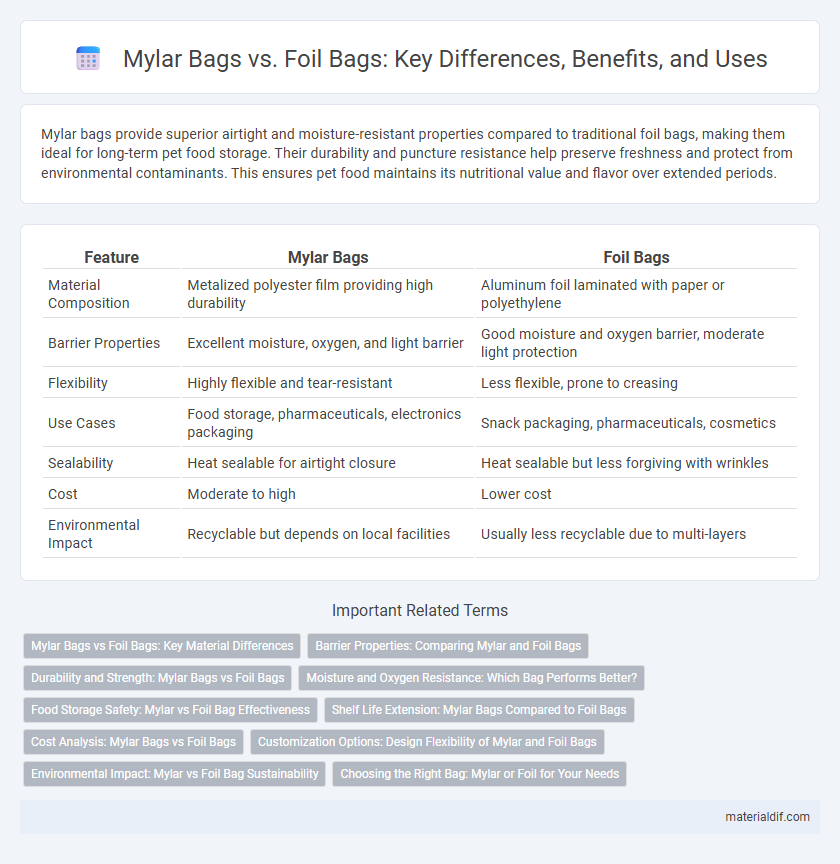Mylar bags provide superior airtight and moisture-resistant properties compared to traditional foil bags, making them ideal for long-term pet food storage. Their durability and puncture resistance help preserve freshness and protect from environmental contaminants. This ensures pet food maintains its nutritional value and flavor over extended periods.
Table of Comparison
| Feature | Mylar Bags | Foil Bags |
|---|---|---|
| Material Composition | Metalized polyester film providing high durability | Aluminum foil laminated with paper or polyethylene |
| Barrier Properties | Excellent moisture, oxygen, and light barrier | Good moisture and oxygen barrier, moderate light protection |
| Flexibility | Highly flexible and tear-resistant | Less flexible, prone to creasing |
| Use Cases | Food storage, pharmaceuticals, electronics packaging | Snack packaging, pharmaceuticals, cosmetics |
| Sealability | Heat sealable for airtight closure | Heat sealable but less forgiving with wrinkles |
| Cost | Moderate to high | Lower cost |
| Environmental Impact | Recyclable but depends on local facilities | Usually less recyclable due to multi-layers |
Mylar Bags vs Foil Bags: Key Material Differences
Mylar bags are made from biaxially-oriented polyethylene terephthalate (BoPET), offering superior tensile strength, flexibility, and resistance to moisture and gases compared to traditional foil bags, which are typically composed of aluminum foil laminated with plastic. The multi-layer structure of Mylar bags provides enhanced barrier properties, making them ideal for long-term food storage by preventing oxygen and light penetration more effectively than standard foil bags. In contrast, foil bags are more prone to punctures and creases, reducing their durability and overall protection against environmental factors.
Barrier Properties: Comparing Mylar and Foil Bags
Mylar bags offer superior oxygen and moisture barrier properties compared to traditional foil bags, making them ideal for long-term food storage and preservation. The high-density polyester film in Mylar provides excellent resistance to punctures and UV light, enhancing product shelf life. Foil bags, while effective in blocking light and air, generally lack the durability and seal integrity found in Mylar bags.
Durability and Strength: Mylar Bags vs Foil Bags
Mylar bags exhibit superior durability and puncture resistance compared to traditional foil bags, making them ideal for long-term storage and protection of sensitive items. The multi-layer polyester film in Mylar offers enhanced strength and resistance to moisture, oxygen, and light, which foil bags often lack. Foil bags tend to be more prone to tearing and do not provide the same level of barrier protection, reducing their effectiveness in preserving contents over extended periods.
Moisture and Oxygen Resistance: Which Bag Performs Better?
Mylar bags offer superior moisture and oxygen resistance compared to foil bags due to their multi-layered polyester film construction combined with aluminum oxide coating, creating an effective barrier against environmental factors. Foil bags, while also providing good protection, tend to be less airtight and more prone to pinholes that allow oxygen and moisture ingress over time. For long-term storage requiring maximum preservation of freshness and shelf life, Mylar bags outperform foil bags by maintaining a more stable, controlled internal atmosphere.
Food Storage Safety: Mylar vs Foil Bag Effectiveness
Mylar bags provide superior food storage safety compared to foil bags due to their multi-layer construction that offers enhanced protection against moisture, oxygen, and light, which are critical factors for preserving food freshness. Unlike single-layer foil bags, Mylar's metallized polyester film creates an effective barrier that significantly reduces the risk of contamination and spoilage over long-term storage. This makes Mylar bags more effective for maintaining the nutritional quality and shelf life of food products in various storage conditions.
Shelf Life Extension: Mylar Bags Compared to Foil Bags
Mylar bags provide superior shelf life extension compared to foil bags due to their multi-layered structure that offers excellent oxygen, moisture, and light barrier properties. The metallized polyester film in Mylar bags significantly reduces permeability, preserving freshness and preventing spoilage for longer periods. While foil bags also offer good protection, Mylar bags typically outperform them in durability and resistance to punctures, ensuring extended product preservation.
Cost Analysis: Mylar Bags vs Foil Bags
Mylar bags generally cost less per unit compared to foil bags, making them a more budget-friendly option for long-term storage and bulk packaging. Foil bags tend to have higher manufacturing costs due to their multi-layered construction and superior barrier properties, which can increase overall expenses for businesses. Evaluating the cost-to-benefit ratio is essential, as Mylar bags offer adequate protection at a lower price, while foil bags provide enhanced durability and moisture resistance at a premium cost.
Customization Options: Design Flexibility of Mylar and Foil Bags
Mylar bags offer superior design flexibility with options for full-color printing, matte or glossy finishes, and customizable sizes, enhancing brand visibility and product appeal. Foil bags, while providing excellent barrier properties, generally have more limited customization capabilities, often restricted to standard silver or gold finishes with minimal printing options. The ability to tailor Mylar bags extensively makes them ideal for businesses seeking unique packaging solutions that stand out on shelves.
Environmental Impact: Mylar vs Foil Bag Sustainability
Mylar bags offer superior environmental sustainability compared to foil bags due to their reusable and recyclable nature, reducing waste and conserving resources. Foil bags, often laminated with plastic and aluminum layers, pose significant recycling challenges and contribute to landfill accumulation. Choosing Mylar bags supports eco-friendly packaging solutions by minimizing environmental footprint and promoting circular economy practices.
Choosing the Right Bag: Mylar or Foil for Your Needs
Mylar bags offer superior durability, moisture resistance, and oxygen barriers, making them ideal for long-term food storage and preservation. Foil bags provide excellent heat resistance and sealed protection, suitable for products requiring thermal insulation or quick shelf access. Selecting between Mylar and foil depends on specific requirements such as durability, shelf life, and environmental conditions.
Mylar Bags vs Foil Bags Infographic

 materialdif.com
materialdif.com